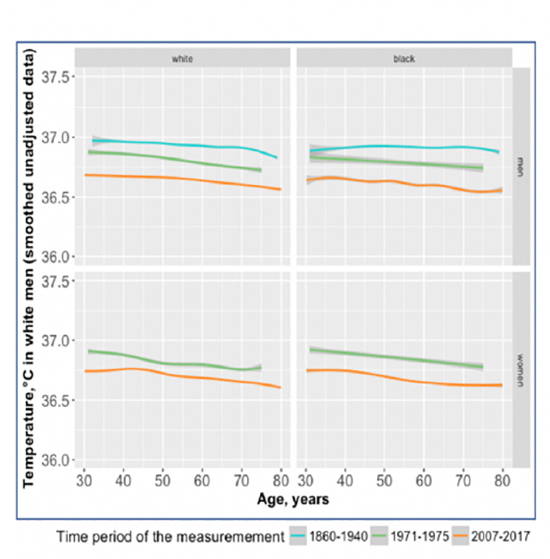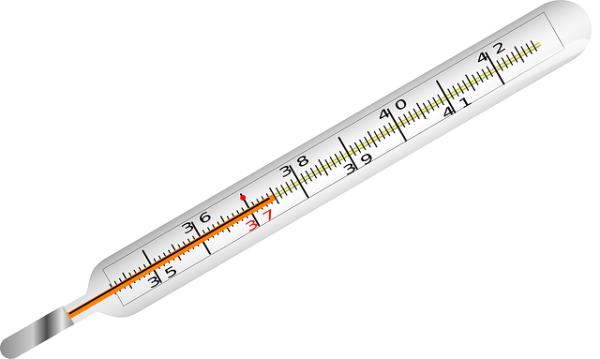Temperature is one of the standard vital signs, with fever typically indicating the presence of an infection. The standard 98.6°F was established by a German physician, Carl Wunderlich, in the mid 18th century based on recordings from 25,000 patients. Dr. Wunderlich’s work, of course, comes with some caveats, most importantly, he took the patient’s temperature from their armpit, axilla, not an oral or rectal temperature. [1] A subsequent study in 1992 using electronic thermometers and temperatures taken orally put the “normal” at 98.2°F and reaffirmed that our temperature varies throughout the day, lower in the morning than evening and that women ran a little higher than men. [2]
But before consigning Dr. Wunderlich’s work to history, is it possible that he was correct and our body temperature has dropped that small amount? That is the subject of a new study looking at body temperature in the US since the mid 18thcentury.
“Human body temperature is a crude surrogate for basal metabolic rate which, in turn, has been linked to both longevity (higher metabolic rate, shorter life span) and body size (lower metabolism, greater body mass). We speculated that the differences observed in temperature between the 19th century and today are real and that the change over time provides important physiologic clues to alterations in human health and longevity since the Industrial Revolution.”

The researchers made use of temperature measurements made from a very old dataset, Union Army Veterans of the Civil War (UVAVCW), that began in 1862 and ended in 1930, as well as two more contemporaneous reports from NHANES, the National Health and Nutrition Examination Study running from 1971 to 1975, and the Stanford Translational Research Integrated Database Environment (STRIDE) from 2007 to 2017 – a total of 670,000 temperature measurements in 190,000 individuals, covering 157 years.
Temperature measurements were higher in the Civil War Veterans than the NHANES participants, who in turn had higher temperatures than the STRIDE participants.
- Our temperature does in fact rise throughout the day by about .018°F to .036°F per hour peaking in the late afternoon.
- Ambient temperature does have a small effect on temperature, a 1°F increase resulting in a 0.018°F or smaller increase in body temperature.
- Body temperature also decreases as we age, by roughly .054°F/decade
Of course, how and with what instrument temperature was measured did vary and the researchers tried to account for those differences, concluding that over the last 150+ years our body temperature has declined by roughly 1°F for men and 0.5°F for women. [3]
Why?
When we burn calories we generate heat. Body temperature is a rough measure of our resting metabolic rate. Bigger bodies have greater metabolic needs, so body temperature increases with body mass, and there are lots of studies to show that Americans are getting bigger which would mean that our temperature should be rising, not falling. So perhaps the falling temperature reflects a declining metabolic rate.
One of the most likely candidates for that decline is our old friend the hygiene hypothesis. Part of our resting metabolism is directed at infections, producing the inflammatory mediators that fight disease and are often cited as the underlying problem with the Western diet and other chronic conditions. If, we are expending less energy to fight infections, because of better water, sanitation, and medical care, then our resting metabolism would decrease.
A large portion of our energy expenditure goes to keeping us in a temperature range where our metabolism actually functions most efficiently. Another possibility to explain the decrease has been an improvement in housing, that allows us to live in more “thermoneutral” environments.
Wunderlich may not have been wrong, we just may be seeing the impact of our actions upon the world reflected back in our physiology. Who knew one of our vital signs could contain so much history and change?
[1] You can read or hear more about Dr. Wunderlich and other medical myths in this episode of Freakonomics, Bad Medicine.
[2] A Critical Appraisal of 98.6°F, the Upper Limit of the Normal Body Temperature, and Other Legacies of Carl Reinhold August Wunderlich JAMA DOI: 1 0.1001/jama.1992.03490120092034
[3] If anything, the researchers feel that the change is underestimated since the Civil War Veterans were often axillary temperatures that are about a degree lower than oral or rectal temperatures.
Source: Decreasing human body temperature in the United States since the Industrial Revolution eLife DOI: 10.7554/eLife.49555




